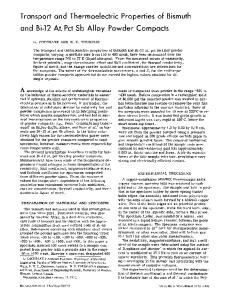Electronic structure and thermoelectric properties of HfRhZ(Z = As, Sb and Bi) half-Heusler compounds
- PDF / 1,435,677 Bytes
- 8 Pages / 595.276 x 790.866 pts Page_size
- 70 Downloads / 403 Views
Electronic structure and thermoelectric properties of HfRhZ(Z = As, Sb and Bi) half‑Heusler compounds Muyiwa K. Bamgbose1 Received: 30 March 2020 / Accepted: 27 May 2020 © Springer-Verlag GmbH Germany, part of Springer Nature 2020
Abstract Huge attention has been shifted to thermoelectric properties of half-Heusler compounds because of the ability of these compounds to convert heat into electricity. The calculations of thermoelectric properties of these compounds are necessitated by the search for alternatives to fossil fuel. This report presents ab initio calculations of electronic and thermoelectric properties of the most stable phase of hafnium–rhodium-based arsenic, antimony and bismuth (HfRhZ(Z = As, Sb and Bi)) half-Heusler compounds by density functional theory based on projector augmented wave pseudopotential method with Perdew–Burke–Ernzerhof generalized gradient approximation used for exchange–correlation functional. The properties calculated in this work are the equilibrium lattice constant, the density of states, band structures, Seebeck coefficients, electrical conductivity, power factor and electronic fitness function (EFF). EFF is calculated to overcome the problem of optimizing Seebeck coefficient and electrical conductivity because of inverse proportion relationship between Seebeck coefficient and electrical conductivity. The 𝛾 phase of these compounds is found to be most stable, and thus, electronic and thermoelectric properties of this phase are obtained for the p-type HfRhZ( Z = As, Sb and Bi). The p-type HfRhZ(Z = As, Sb and Bi) is a better thermoelectric material than the n-type HfRhZ(Z = As, Sb and Bi). The Seebeck coefficients of these compounds are 272.01 μV/K, 555.75 μV/K and 244.92 μV/K for HfRhAs, HfRhSb and HfRhBi, respectively, and EFF of HfRhAs, HfRhSb and HfRhBi is 1.21×10−19 W5∕3 ms−1∕3 K−2 at 1.75×1020 cm−3 , 1.55×10−19 W5∕3 ms−1∕3 K−2 at 1.64×1020 cm−3 and 1.07×10−19 W5∕3 ms−1∕3 K−2 at 4.50×1020 cm−3 , respectively. The results obtained in this work show that HfRhSb and HfRhAs are better potential thermoelectric materials than some known high-performance thermoelectric materials. Keywords Electronic · Properties · Thermoelectric · Heusler · Compounds
1 Introduction The world fossil energy consumption is increasing geometrically, and this consumption is as a result of everyday human needs. The world energy source percentages are: The fossil fuel source is 85%, the nuclear source of energy is 4% and the renewable energy source is 11% [1]. The largest percentage occupied by fossil fuel consumption calls for concern. Global warming can be greatly reduced by minimization of the adverse effect of fossil fuel combustion. The conversion of waste heat from the combustion of fossil fuel will greatly reduce the hazard post by fossil fuel combustion. The conversion of this waste heat into electricity is currently a * Muyiwa K. Bamgbose [email protected] 1
Department of Physics, Augustine University, Ilara-Epe, Lagos, Nigeria
necessity, and this conversion can be tremendou
Data Loading...











